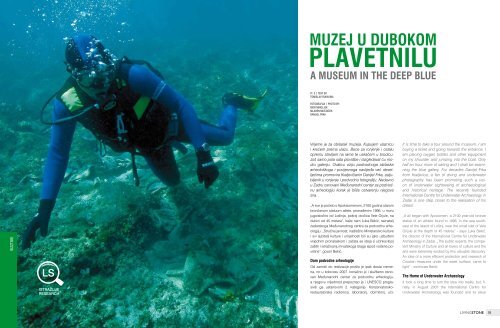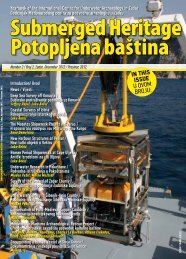Muzej u dubokom plavetnilu - Međunarodni centar za podvodnu ...
Muzej u dubokom plavetnilu - Međunarodni centar za podvodnu ...
Muzej u dubokom plavetnilu - Međunarodni centar za podvodnu ...
You also want an ePaper? Increase the reach of your titles
YUMPU automatically turns print PDFs into web optimized ePapers that Google loves.
MUZEJ U DUBOKOM<br />
PLAVETNILU<br />
A MUSEUM IN THE DEEP BLUE<br />
Piše | Text by:<br />
TOMISLAV RUKAVINA<br />
FOTOGRAFIJA | PHOTO BY:<br />
Igor Miholjek<br />
Mladen Mustaček<br />
danijel frka<br />
BIZZTIME<br />
Vrijeme je <strong>za</strong> obila<strong>za</strong>k muzeja. Kupujem ulaznicu<br />
i krećem prema ulazu. Boce <strong>za</strong> ronjenje i ostalu<br />
opremu stavljam na rame te uskačem u brodicu.<br />
Još samo pola sata plovidbe i razgledavat ću modru<br />
galeriju. Ovakvu viziju podvodnoga obilaska<br />
arheološkoga i povijesnoga naslijeđa već desetljećima<br />
promovira Kraljevičanin Danijel Frka, <strong>za</strong>ljubljenik<br />
u ronjenje i <strong>podvodnu</strong> fotografiju. Nedavno<br />
u Zadru osnovani <strong>Međunarodni</strong> <strong>centar</strong> <strong>za</strong> <strong>podvodnu</strong><br />
arheologiju korak je bliže ostvarenju njegova<br />
sna.<br />
„A sve je počelo s Apoksiomenom, 2100 godina starom<br />
brončanom statuom atlete, pronađenim 1996. u moru<br />
jugoistočno od Lošinja, pokraj otočića Vele Orjule, na<br />
dubini od 45 metara”, kaže nam Luka Bekić, ravnatelj<br />
<strong>za</strong>darskoga Međunarodnog centra <strong>za</strong> <strong>podvodnu</strong> arheologiju.<br />
„Stručna javnost, nadležno Ministarstvo kulture<br />
i svi ljubitelji kulture i umjetnosti bili su jako uzbuđeni<br />
vrijednim pronalaskom i <strong>za</strong>čela se ideja o učinkovitijoj<br />
<strong>za</strong>štiti i istraživanju hrvatskoga blaga ispod vodene površine”,<br />
govori Bekić.<br />
Dom podvodne arheologije<br />
Od <strong>za</strong>misli do reali<strong>za</strong>cije prošlo je ipak dosta vremena,<br />
no u kolovozu 2007. konačno je i službeno osnovan<br />
<strong>Međunarodni</strong> <strong>centar</strong> <strong>za</strong> <strong>podvodnu</strong> arheologiju,<br />
a njegovu vrijednost prepoznao je i UNESCO proglasivši<br />
ga ustanovom 2. kategorije. Konzervatorskorestauratorska<br />
radionica, laboratorij, dormitorij, uči-<br />
It is time to take a tour around the museum. I am<br />
buying a ticket and going towards the entrance. I<br />
am placing oxygen bottles and other equipment<br />
on my shoulder and jumping into the boat. Only<br />
half an hour more of sailing and I shall be examining<br />
the blue gallery. For decades Danijel Frka<br />
from Kraljevica, a fan of diving and underwater<br />
photography has been promoting such a vision<br />
of underwater sightseeing of archaeological<br />
and historical heritage. The recently founded<br />
International Centre for Underwater Archaeology in<br />
Zadar is one step closer to the realisation of his<br />
dream.<br />
„It all began with Apoxiomen, a 2100 year-old bronze<br />
statue of an athlete found in 1996, in the sea southeast<br />
of the island of Lošinj, near the small islet of Vele<br />
Orijule at the depth of 45 metres” - says Luka Bekić,<br />
the director of the International Centre for Underwater<br />
Archaeology in Zadar. „The public experts, the competent<br />
Ministry of Culture and all lovers of culture and the<br />
arts were extremely excited by this valuable discovery.<br />
An idea of a more efficient protection and research of<br />
Croatian treasures under the water surface, came to<br />
light” - continues Bekić.<br />
The Home of Underwater Archaeology<br />
It took a long time to turn the idea into reality, but, finally,<br />
in August 2007 the International Centre for<br />
Underwater Archaeology was founded and its value<br />
58 59
BIZZTIME<br />
MUZEJ U DUBOKOM PLAVETNILU | A MUSEUM IN THE DEEP BLUE<br />
<strong>Međunarodni</strong> <strong>centar</strong> <strong>za</strong> <strong>podvodnu</strong> arheologiju u Zadru, čiju je vrijednost prepoznao i UNESCO proglasivši ga ustanovom 2. kategorije / International Centre for Underwater<br />
Archaeology in Zadar was recognised by UNESCO that pronounced it a category 2 centre<br />
jedinstvenom slučaju gdje su se te rupičaste<br />
keramičke posude očuvale na originalnom<br />
mjestu (in situ). Nerijetko, nađu se i ostatci<br />
namjerno potopljenih brodova koji su na<br />
ulazima u luke neprijateljima priječili pristup<br />
s morske strane. Dva takva broda izvađena<br />
su iz mora 1974. godine pred Ninom, a kasnije<br />
je doka<strong>za</strong>no kako su brodovi iz 11. stoljeća<br />
te da su potopljeni tijekom obrane od<br />
napada Normana na hrvatsku obalu 1074.<br />
godine.<br />
<strong>Muzej</strong>i u kavezu<br />
Nažalost, turi<strong>za</strong>m te razvitak sportskoga<br />
ronjenja uz spužvarstvo i koraljarstvo prouzročili<br />
su nenadoknadive štete. Teret mnogobrojnih<br />
potopljenih brodova je <strong>za</strong>uvijek nestao<br />
ili je oštećen, a poznato je da su mnogi<br />
nalazi našli svoje mjesto u privatnim zbirkama.<br />
Amfore su postale simbol podmorske<br />
arheološke baštine, ali i njezine devastacije.<br />
Ipak hrvatski znanstvenici su tom haraču<br />
našli lijeka.<br />
Od 1990. godine važna arheološka nalazišta<br />
<strong>za</strong>štićena su kavezima, što je jedinstven<br />
način <strong>za</strong>štite u svijetu. Pristup je moguć jedino<br />
kroz poseban otvor. Takvih kavezom <strong>za</strong>of<br />
Stonac, parts of large ceramic pots were<br />
preserved. These pots could hold 1,000 litres<br />
and in ancient times they were used for<br />
storing agricultural and sea products. This<br />
is a unique case, because these perforated<br />
ceramic pots were preserved in their original<br />
location (in situ). Often, remains of deliberately<br />
sunk ships can be found. Such ships<br />
were used to prevent enemies, approaching<br />
from the sea, to enter ports. Two such ships<br />
were extracted from the sea in 1974 in front<br />
of Nin, and later on it was proved that the<br />
ships originated from the 11th century and<br />
that they were sunk during the Norman attack<br />
of the Croatian coastline in 1074.<br />
Museum In a Cage<br />
Unfortunately, tourism and the development<br />
of sport diving with sponge and coral diving<br />
have caused irrecoverable damages.<br />
The cargo of numerous sunken ships has<br />
gone forever or has been damaged and it is<br />
known that many ended up in private collections.<br />
Amphoras have become a symbol of<br />
undersea archaeological heritage, but also<br />
of its devastation. Still, Croatian scientists<br />
have found a solution for this plundering.<br />
<strong>Međunarodni</strong> <strong>centar</strong> <strong>za</strong> <strong>podvodnu</strong><br />
arheologiju tijekom rujna bit će domaćin<br />
eminentnoga skupa svjetskih znanstvenika<br />
koji se bave proučavanjem i <strong>za</strong>štitom<br />
arheološke i povijesne podvodne<br />
baštine. Taj skup bit će još jedan<br />
doprinos promociji podvodne arheologije<br />
i hrvatskoga ronilačkog turizma te<br />
hrvatskom načinu <strong>za</strong>štite podvodnih<br />
arheoloških nalazišta – in situ.<br />
During September, the International<br />
Centre for Underwater Archaeology<br />
will host an eminent meeting of world<br />
scientists who are engaged in research<br />
and the protection of archaeological<br />
and historical underwater heritage. This<br />
meeting will be one more contribution to<br />
the promotion of underwater archaeology,<br />
the Croatian diving tourism and the<br />
Croatian way of protecting underwater<br />
archaeological sites – in situ.<br />
onica <strong>za</strong> predavanja, uredi i drugi prateći sadržaji u sklopu centra<br />
omogućavaju znanstvenicima kvalitetan rad na <strong>za</strong>štiti povijesne podvodne<br />
baštine. Kažemo podvodne, a ne podmorske, jer u Centru se<br />
brinu i o nalazištima u hrvatskim rijekama i jezerima.<br />
Ronjenje je odavno postalo dostupno gotovo svima, a već na malim<br />
dubinama se pronalaze ostatci sidrišta, pristaništa i luka, ladanjskih<br />
vila ili čak tragovi nekadašnjih naselja. Većina poznatih priobalnih<br />
nalazišta potječe iz antičkoga ili rimskoga doba.<br />
„Gotovo 80 posto ronilaca koje susrećem žele obići podmorska<br />
nalazišta povijesne i arheološke baštine”, pojašnjava nam Danijel<br />
Frka važnost upravljanja naslijeđenim blagom.<br />
Bezbroj nalazišta<br />
Vrijednih podvodnih arheoloških nalazišta ima doslovce posvuda<br />
na Jadranu. U Kaštelanskome <strong>za</strong>ljevu u plitkom moru otkrivene su<br />
antičke konstrukcije izrađene od drveta, katkad u kombinaciji s recikliranim<br />
amforama ili čak namjerno potopljenim brodom. Uvala Sv.<br />
Jurja, poznatija kao luka Vis, još je jedan primjer dobro očuvane, ali<br />
turistički neiskorištene baštine. U uvali Stonca očuvali su se dijelovi<br />
velikih keramičkih posuda. Riječ je o posudama kapaciteta oko 1.000<br />
litara, kojima su se u antičko vrijeme koristili <strong>za</strong> skladištenje poljoprivrednih<br />
proizvoda i proizvoda morskoga gospodarstva. Riječ je i o<br />
was recognised by UNESCO that pronounced it a Category 2 Centre.<br />
Conservation-restoration workshop, laboratory, dormitory, lecture<br />
classrooms, offices and other accompanying facilities within the<br />
Centre enable the scientists to conduct high-quality work on the protection<br />
of the historical underwater heritage. We say underwater and<br />
not undersea, because in the Centre they take care also of sites in<br />
Croatian rivers and lakes.<br />
Since long, diving has become accessible to almost everyone and<br />
one can find remains of anchorages, quays and ports, summer villas<br />
or even traces of past settlements at shallow depths. Most of the<br />
coastal finding places originate from the ancient or Roman period.<br />
„Almost 80 percent of divers that I meet wish to tour the undersea<br />
sites of historical and archaeological heritage”– Danijel Frka explains<br />
the importance of managing the inherited treasure.<br />
Numerous Finding Places<br />
There are valuable underwater archaeological sites all over the<br />
Adriatic. In the Bay of Kaštel in shallow waters ancient constructions<br />
were found. They were made of wood, sometimes in combination<br />
with recycled amphoras or even with a deliberately sunk ship. The<br />
cove of Sv.Juraj, known as the port of Vis is another example of a well<br />
preserved, but in terms of tourism, unexploited heritage. In the cove<br />
U Hrvatsku svako ljeto dolazi oko 30.000 stranih ronilaca / Around 30,000 foreign divers come to Croatia every summer<br />
60 61
BIZZTIME<br />
MUZEJ U DUBOKOM PLAVETNILU | A MUSEUM IN THE DEEP BLUE<br />
Amfore su postale simbol podmorske arheološke baštine, a važna nalazišta <strong>za</strong>štićena su kavezima, što je jedinstven način <strong>za</strong>štite u svijetu<br />
Amphoras have become a symbol of undersea archaeological heritage, and important sites have been protected with cages which is a unique way of protection in the world<br />
Olupina putničkog broda Baron Gautch u podmorju rovinjskog arhipelaga, koji je 1914. naletio na minu, omiljena je ronilačka atrakcija<br />
The wreck of the passenger ship Baron Gautch, in the underwaters or Rovinj archipelago, which was hit by a mine in 1914, is one of the most popular diving attractions<br />
štićenih nalazišta u Hrvatskoj ima osam, a nose naziv „podmorski<br />
muzeji”. Ronilački klubovi koji su od Ministarstva kulture dobili koncesiju,<br />
sada imaju ekskluzivno pravo voditi turiste u te „muzeje”. Jedno<br />
takvo nalazište je u blizini otočića Supetar pokraj Cavtata. Tu je brod<br />
s teretom amfora iz 3. / 4. stoljeća poslije Krista. Njegova dužina je<br />
oko 30 metara, a nosio je nekoliko tisuća amfora. U cavtatskom području<br />
nađeno je još ostataka potopljenih brodova, pa bi se moglo<br />
reći da je to područje prvi podmorski arheološki park u Hrvatskoj.<br />
Preostali kavezi nalaze se na području otoka Mljeta (Klačina), otoka<br />
Žirja (uvala Koromašna), otoka Paga (uvala Vlaška mala), otoka<br />
Raba (rt Sorinj) i pokraj Umaga. Rješenje s kavezima, koji podvodno<br />
nalazište pretvaraju u muzej, a ujedno i osiguravaju od pljačke, naišlo<br />
je na veliko <strong>za</strong>nimanje i odobravanje u svijetu. Takvo rješenje daje<br />
izvrstan potencijal <strong>za</strong> razvoj ronilačkoga i kulturnoga turizma.<br />
I rijeke kriju svoje tajne<br />
Podvodna arheološka baština ne nalazi se samo u podmorju već i u<br />
rijekama i jezerima kojih je u Hrvatskoj mnogo. Rijeke skrivaju mnoge<br />
vrijedne predmete koji su tisućljećima padali u vodu na važnim pri-<br />
Since 1990, important archaeological sites have been protected<br />
with cages which is a unique way of protection in the world. One<br />
can access them only through a special opening. In Croatia there<br />
are eight sites that are protected in this manner and they carry the<br />
name of „underwater museums”. The diving clubs that were given<br />
a concession by the Ministry of Culture now have the exclusive right<br />
to take tourists to these „museums”. One such site is located in the<br />
vicinity of the small islet Supetar near Cavtat. Here is a ship with a<br />
cargo of amphoras from the 3rd - 4th century AD. Her length is about<br />
30 metres, and she carried several thousand amphoras. In the Cavtat<br />
region several other remains of ships were found, so one could say<br />
that this region is the first undersea archaeological park in Croatia.<br />
The remaining cages are located in the areas around the island of<br />
Mljet (Klačina), island Žirje (cove Koromašna), island Pag (cove<br />
Vlaška mala and cape Sorinj) and near Umag. The solution with the<br />
cages that turn an underwater site into a museum, but also ensure it<br />
against plundering, aroused great interest and approval in the world.<br />
Such a solution represents an excellent potential for the development<br />
of diving and cultural tourism.<br />
jelazima ili su žrtvovani vodenim božanstvima. Korita rijeka skrivaju<br />
ostatke naselja, pristaništa, brodolome i stare mostove. Uz jake riječne<br />
struje, u toj mutnoj vodi nemoguća je prezentacija ispod površine.<br />
Ipak, možemo povjerovati da će dobro ispričana priča i rekonstrukcija<br />
brodova koji su nekada plovili našim rijekama turistima u posebnim<br />
muzejskim postavima dočarati kako se nekada živjelo uz vodu te<br />
obogatiti turističku ponudu kontinentalne Hrvatske.<br />
U Hrvatsku ljeti dolazi oko 30.000 stranih ronilaca. Razloga <strong>za</strong><br />
njihovu ljubav prema Jadranu ima mnogo. U hrvatskom podmorju<br />
čekaju ih mnogobrojni otkriveni i <strong>za</strong>štićeni arheološki lokaliteti, ali i<br />
oko 1500 neistraženih špilja i jama, kao i brodovi i avioni iz prošlih ratova<br />
čija je pozicija otprilike poznata, no olupine još nisu pronađene.<br />
I<strong>za</strong>zova, <strong>za</strong> atraktivan i aktivan odmor na Jadranu, na pretek. A<br />
Rivers Also Hide Their Secrets<br />
Underwater archaeological heritage is not only found in the undersea<br />
areas, but also in rivers and lakes which are in abundance in Croatia.<br />
Rivers hide many valuable items that have been falling into the water<br />
on significant crossings or were sacrificed to water divinities. The<br />
river basins hide remains of settlements, quays, shipwrecks and old<br />
bridges. A presentation below the surface is impossible due to the<br />
strong river currents and the turbid water. Still, it is possible to believe<br />
that a well told story and a reconstruction of ships that once used to<br />
sail in our rivers will, in special museum exhibitions conjure up for the<br />
tourists how people lived along the water and enrich the tourist offer<br />
of continental Croatia.<br />
Around 30,000 foreign divers come to Croatia every summer.<br />
There are many reasons for their love of the Adriatic. In the Croatian<br />
undersea, numerous discovered and protected archaeological sites<br />
are waiting for them, but there are also about 1,500 unexplored caves<br />
and pits, as well as ships and planes from previous wars, whose position<br />
is only vaguely known, but the wreckages have not been discovered<br />
yet. Challenges for an attractive and active vacation on the<br />
Adriatic are plentiful. A<br />
62 63
Marina Punat<br />
45 Years of Tradition and Experience<br />
Safety that you deserve<br />
Yacht service, spare parts shop, restaurants, hotel, tennis court,<br />
800 berths, 500 dry berths, dry-docks, lifting up to 600 tones,<br />
car parking, trailer parking<br />
www.marina-punat.hr







